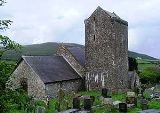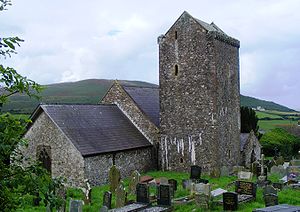
Llangennith
Encyclopedia
Llangennith is a village in Gower
, in the City and County of Swansea
, south Wales
. It sits at a crossroads in northwest Gower: Moor Lane leads westwards to a caravan park near Rhossili Bay; while Burrows Lane leads northwards to a caravan park overlooking Broughton Bay
. The village has a scattering of houses, centred on St Cenydd
's church, and one pub - the King's Head. The neighbouring bay is popular with surfers.
(also Kyned/Cynydd) - the largest in Gower - which was founded in the 6th century, in the days of the undivided Church. According to legend the church was established as a hermitage by St Cenydd; but in 986 the early buildings were destroyed by Vikings. The present structure dates from the 12th century - it was consecrated in 1102 - when Norman war-lords were building castles and churches all over Gower, as elsewhere in Britain. The large fortified square tower is unusually placed north of the nave and features remnants of a significant Norman arch in its east wall, possibly associated with a small priory which was attached to the church through the middle ages. The church is the reputed burial place of Iestyn ap Gwrgant
, the last ruler of the Welsh kingdom of Morgannwg, who is said to have become a religious at Llangennith after being deposed by the Norman Robert Fitzhamon
in 1090. The church contains the mutilated effigy of a 13th-century knight known locally as 'the Dolly Mare' and believed to represent a member of the de la Mere family who held lands nearby, and a significant Norman font. The church interior was restored and remodelled in the 1880s, and the interior floor raised by several feet to counteract damp. The remodelling was relatively restrained and the church retains many original features.
A recently rediscovered mediaeval niche in the chancel arch displays a significant carved slab of around the 9th century, featuring intricate Celtic knots. This is legendarily the former grave stone of St Cenydd and, until the nineteenth century remodelling, was set flat in the chancel floor.
On the village green oppostite the church gates is the mouth of a natural spring, St Cenydd's Well, on the upper capstone of which are faint traces of a cross cut into the stone.
A short stroll south of the church is the ruined medieval village of Coety Green.
 Llangennith was at one time the most infamous, rough-and-ready village on the peninsula, its villagers referred to in Gower dialect
Llangennith was at one time the most infamous, rough-and-ready village on the peninsula, its villagers referred to in Gower dialect
as 'Llangenny Oxen', always the first to rush to any shipwreck, particularly those in Rhossili Bay, and feuding with neighbouring villagers over any plunder they could find.
During World War One, when the British government introduced daylight saving, the villagers held a public meeting - and graciously voted to fall in line with the rest of the country, for a trial period of one month.
In the churchyard are buried the Gower folk-singer, Phil Tanner, who died in 1950; and Anthony Eyre DFC (1918-1946)
. The bay stretches for over three miles, and whilst wandering along the water's edge you can witness the power of the sea pounding onto the shore. If you have never tried surfing, this is the place to give it a go, there being several surfing schools providing lessons during the summer. The beach is backed by sand dunes, and at the north end is the island of Burry Holms
.

Gower Peninsula
Gower or the Gower Peninsula is a peninsula in south Wales, jutting from the coast into the Bristol Channel, and administratively part of the City and County of Swansea. Locally it is known as "Gower"...
, in the City and County of Swansea
Swansea
Swansea is a coastal city and county in Wales. Swansea is in the historic county boundaries of Glamorgan. Situated on the sandy South West Wales coast, the county area includes the Gower Peninsula and the Lliw uplands...
, south Wales
Wales
Wales is a country that is part of the United Kingdom and the island of Great Britain, bordered by England to its east and the Atlantic Ocean and Irish Sea to its west. It has a population of three million, and a total area of 20,779 km²...
. It sits at a crossroads in northwest Gower: Moor Lane leads westwards to a caravan park near Rhossili Bay; while Burrows Lane leads northwards to a caravan park overlooking Broughton Bay
Broughton Bay
Broughton Bay is a beach of the Gower Peninsula, south Wales, located at the north western tip. The bay is backed by sand dunes further inland. Access to the adjacent Whiteford Sands beach to the west is only available at low tide....
. The village has a scattering of houses, centred on St Cenydd
Cenydd
Cenydd was a Christian hermit saint who lived in Britain in Gower and in France in Brittany, probably in the 6th century...
's church, and one pub - the King's Head. The neighbouring bay is popular with surfers.
History
The village of Llangennith clusters round a central village green and the church of St CenyddCenydd
Cenydd was a Christian hermit saint who lived in Britain in Gower and in France in Brittany, probably in the 6th century...
(also Kyned/Cynydd) - the largest in Gower - which was founded in the 6th century, in the days of the undivided Church. According to legend the church was established as a hermitage by St Cenydd; but in 986 the early buildings were destroyed by Vikings. The present structure dates from the 12th century - it was consecrated in 1102 - when Norman war-lords were building castles and churches all over Gower, as elsewhere in Britain. The large fortified square tower is unusually placed north of the nave and features remnants of a significant Norman arch in its east wall, possibly associated with a small priory which was attached to the church through the middle ages. The church is the reputed burial place of Iestyn ap Gwrgant
Iestyn ap Gwrgant
Iestyn ap Gwrgant was the last ruler of the Welsh kingdom of Morgannwg, which encompassed the counties of Glamorgan and Monmouthshire .- Lineage :...
, the last ruler of the Welsh kingdom of Morgannwg, who is said to have become a religious at Llangennith after being deposed by the Norman Robert Fitzhamon
Robert Fitzhamon
Robert Fitzhamon , or Robert FitzHamon, Sieur de Creully in the Calvados region and Torigny in the Manche region of Normandy, was Lord of Gloucester and the Norman conqueror of Glamorgan, southern Wales...
in 1090. The church contains the mutilated effigy of a 13th-century knight known locally as 'the Dolly Mare' and believed to represent a member of the de la Mere family who held lands nearby, and a significant Norman font. The church interior was restored and remodelled in the 1880s, and the interior floor raised by several feet to counteract damp. The remodelling was relatively restrained and the church retains many original features.
A recently rediscovered mediaeval niche in the chancel arch displays a significant carved slab of around the 9th century, featuring intricate Celtic knots. This is legendarily the former grave stone of St Cenydd and, until the nineteenth century remodelling, was set flat in the chancel floor.
On the village green oppostite the church gates is the mouth of a natural spring, St Cenydd's Well, on the upper capstone of which are faint traces of a cross cut into the stone.
A short stroll south of the church is the ruined medieval village of Coety Green.

Gower dialect
The Gower Peninsula on the south Wales coast was Normanised/Anglicised relatively early after the Norman conquest of England. Relatively cut off from the Welsh hinterland, but with coastal links across south Wales and the West Country, the region developed a distinct English dialect which endured...
as 'Llangenny Oxen', always the first to rush to any shipwreck, particularly those in Rhossili Bay, and feuding with neighbouring villagers over any plunder they could find.
During World War One, when the British government introduced daylight saving, the villagers held a public meeting - and graciously voted to fall in line with the rest of the country, for a trial period of one month.
In the churchyard are buried the Gower folk-singer, Phil Tanner, who died in 1950; and Anthony Eyre DFC (1918-1946)
Physical features
The beach is now mainly a centre for surfers, and is located at the north end of Rhosili Bay in a fairly isolated locale. There are gentle walks north-west to the coast over the sand dunes of Llangennith and Broughton Burrows. Sights to watch out for include Blue Pool, a rock pool which, in the right sea and sky conditions, takes a deep blue colour; the natural archway called Three Chimneys; and Culver Hole, a bone cave. Llangennith is a popular surfing location mainly because of the consistent swells that pour in from the Atlantic OceanAtlantic Ocean
The Atlantic Ocean is the second-largest of the world's oceanic divisions. With a total area of about , it covers approximately 20% of the Earth's surface and about 26% of its water surface area...
. The bay stretches for over three miles, and whilst wandering along the water's edge you can witness the power of the sea pounding onto the shore. If you have never tried surfing, this is the place to give it a go, there being several surfing schools providing lessons during the summer. The beach is backed by sand dunes, and at the north end is the island of Burry Holms
Burry Holms
Burry Holms is a small tidal island located at the northern end of the Gower Peninsula, Wales. 9,000 years ago it was up to 12 miles away from the sea and inhabited by nomadic Mesolithic hunters...
.
Notable residents
- CenyddCenyddCenydd was a Christian hermit saint who lived in Britain in Gower and in France in Brittany, probably in the 6th century...
- saint - Tracy EdwardsTracy EdwardsTracy Edwards MBE is a British sailor. In 1989 she skippered the first all-female crew in the Whitbread Round the World Yacht Race, becoming the first woman to receive the Yachtsman of the Year Trophy and was awarded the Order of the British Empire.-Bibliography:Maiden. Simon & Schuster, 13...
- yachtswoman - Ryan JonesRyan JonesRyan Paul Jones is a Welsh international rugby union player who plays at number eight for the Ospreys. He is able to cover blindside flanker and second row; he played second row in his younger days as he was kept out of his preferred number 8 role by Gareth Delve.-Early life:Jones played junior...
- Wales Rugby International - Pete Jones - 'PJ' - ex Welsh, British & European SurfingSurfingSurfing' is a surface water sport in which the surfer rides a surfboard on the crest and face of a wave which is carrying the surfer towards the shore...
Champion, Local surf legend and shop owner
External links
- St. Cenydd's Church, Llangennith
- Llangennith surf cam
- Llangennith, Llanmadoc and Cheriton Community Council
- Llangennith, Llanmadoc and Cheriton community/parish magazine- village, community and regional information, current affairs and history


